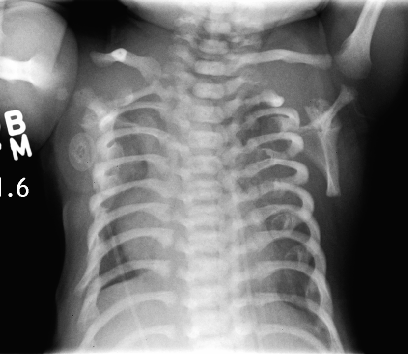Short-Rib Thoracic Dysplasia 2 With Or Without Polydactyly

A number sign (#) is used with this entry because short-rib thoracic dystrophy-2 with or without polydactyly (SRTD2) is caused by homozygous mutation in the IFT80 gene (611177) on chromosome 3q25.
DescriptionShort-rib thoracic dysplasia (SRTD) with or without polydactyly refers to a group of autosomal recessive skeletal ciliopathies that are characterized by a constricted thoracic cage, short ribs, shortened tubular bones, and a 'trident' appearance of the acetabular roof. SRTD encompasses Ellis-van Creveld syndrome (EVC) and the disorders previously designated as Jeune syndrome or asphyxiating thoracic dystrophy (ATD), short rib-polydactyly syndrome (SRPS), and Mainzer-Saldino syndrome (MZSDS). Polydactyly is variably present, and there is phenotypic overlap in the various forms of SRTDs, which differ by visceral malformation and metaphyseal appearance. Nonskeletal involvement can include cleft lip/palate as well as anomalies of major organs such as the brain, eye, heart, kidneys, liver, pancreas, intestines, and genitalia. Some forms of SRTD are lethal in the neonatal period due to respiratory insufficiency secondary to a severely restricted thoracic cage, whereas others are compatible with life (summary by Huber and Cormier-Daire, 2012 and Schmidts et al., 2013).
There is phenotypic overlap with the cranioectodermal dysplasias (Sensenbrenner syndrome; see CED1, 218330).
For a discussion of genetic heterogeneity of short-rib thoracic dysplasia, see SRTD1 (208500).
Clinical FeaturesBeales et al. (2007) reported 3 consanguineous families with a form of asphyxiating thoracic dystrophy: 2 families were from Pakistan and 1 was from Turkey. The Turkish child had a narrow chest, short femora, and postaxial polydactyly on the hands and feet. One of the Pakistani families had 2 affected children. One child had short femora, narrow chest, and brachydactyly with broad hands and small feet. Skeletal survey showed trident acetabular roofs, mild bowing of the femurs, and small middle phalanges. The second child in this family had short femora, narrow chest, and rhizomelic limb shortening. Neither child had internal organ abnormalities or neonatal respiratory problems. The proband in the second Pakistani family was born stillborn at 20 weeks' gestation due to chorioamnionitis. Autoradiography showed mesomelic shortening of the lower limb with curved femora and trident acetabular roofs. There was no polydactyly, but the hands had short middle phalanges and metacarpals. There were no internal organ abnormalities.
Tuysuz et al. (2009) restudied the Turkish girl reported by Beales et al. (2007) and noted that she had atlantoaxial instability and spinal cord compression, features not previously reported in asphyxiating thoracic dystrophy.
MappingBy genomewide screening, Beales et al. (2007) identified a 17-cM region of homozygosity on chromosome 3q24-q25 that was shared by 3 consanguineous families with asphyxiating thoracic dystrophy. The region was located between markers D3S1555 and D3S1574.
Molecular GeneticsIn members of 3 consanguineous families with a clinical diagnosis of asphyxiating thoracic dystrophy, Beales et al. (2007) identified 3 different homozygous mutations in the IFT8 gene (611177.0001-611177.0003).
In a patient with a clinical diagnosis of lethal short-rib polydactyly syndrome, Cavalcanti et al. (2011) identified a homozygous missense mutation in the IFT80 gene (611177.0004). The patient had preaxial polydactyly.